ghulam rasool santosh
︎Artist, Painting, Spirituality
︎ Ventral Is Golden
ghulam rasool santosh
︎Artist, Painting, Spirituality
︎ Ventral Is Golden
︎ Ventral Is Golden
"There is no word of wider content in any language than this Sanskrit term meaning 'Power'. For Shakti in the highest causal sense is God as Mother.”
- Arthur Avalon.
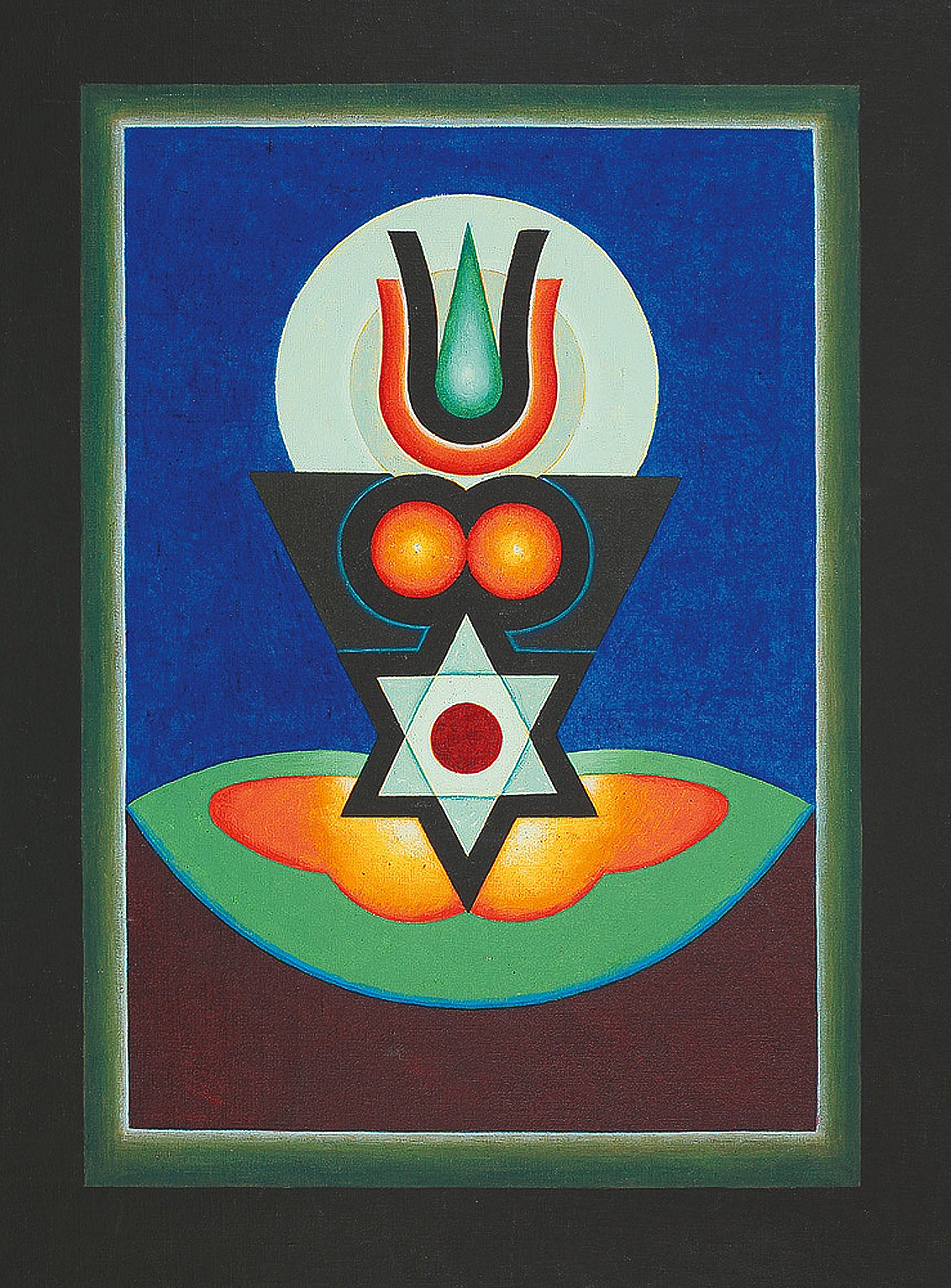
Originally beginning his career as a landscape painter in his native Kashmir, Santosh’s art changed dramatically towards the tradition of tantra after undergoing a mystical experience in the Amarnath cave in 1964. From then on, until his death in 1997, Santosh dedicated his life to the esoteric practice of tantra and the study of sacred geometry.
Within modern Indian art, Ghulam Rasool Santosh was synonymous with the school that came to be known as Neo-Tantra. Early in his career, Santosh had a deep admiration for Cezanne and the Cubist treatment of pictorial space, that situated objects inside a fluid geometry in order to penetrate conventional three dimensionality to reveal all of their relative perspectives in space, fused within a single observer. Possibly for Santosh, as well as for the Cubists, this was a deeper and more persistent phenomena of the archaic vision of space and time - a way of reconciling the mystical experience into a geometric language.
Borrowing similar motifs from traditional Buddhist Thangka art, as well as more modern symbolical systems found in theosophical paintings and alchemical sigils, Neo-Tantrism sits on the boundries of abstractionism and formalism, whilst the essence of tantric teaching still remains relatively unacknowledged in the Western philosophical, scientific and artistic canons, even though they share some origins within Asian and Middle Eastern regions before migrating West to influence mathematics, astrology and other associated fields.
Within modern Indian art, Ghulam Rasool Santosh was synonymous with the school that came to be known as Neo-Tantra. Early in his career, Santosh had a deep admiration for Cezanne and the Cubist treatment of pictorial space, that situated objects inside a fluid geometry in order to penetrate conventional three dimensionality to reveal all of their relative perspectives in space, fused within a single observer. Possibly for Santosh, as well as for the Cubists, this was a deeper and more persistent phenomena of the archaic vision of space and time - a way of reconciling the mystical experience into a geometric language.
Borrowing similar motifs from traditional Buddhist Thangka art, as well as more modern symbolical systems found in theosophical paintings and alchemical sigils, Neo-Tantrism sits on the boundries of abstractionism and formalism, whilst the essence of tantric teaching still remains relatively unacknowledged in the Western philosophical, scientific and artistic canons, even though they share some origins within Asian and Middle Eastern regions before migrating West to influence mathematics, astrology and other associated fields.
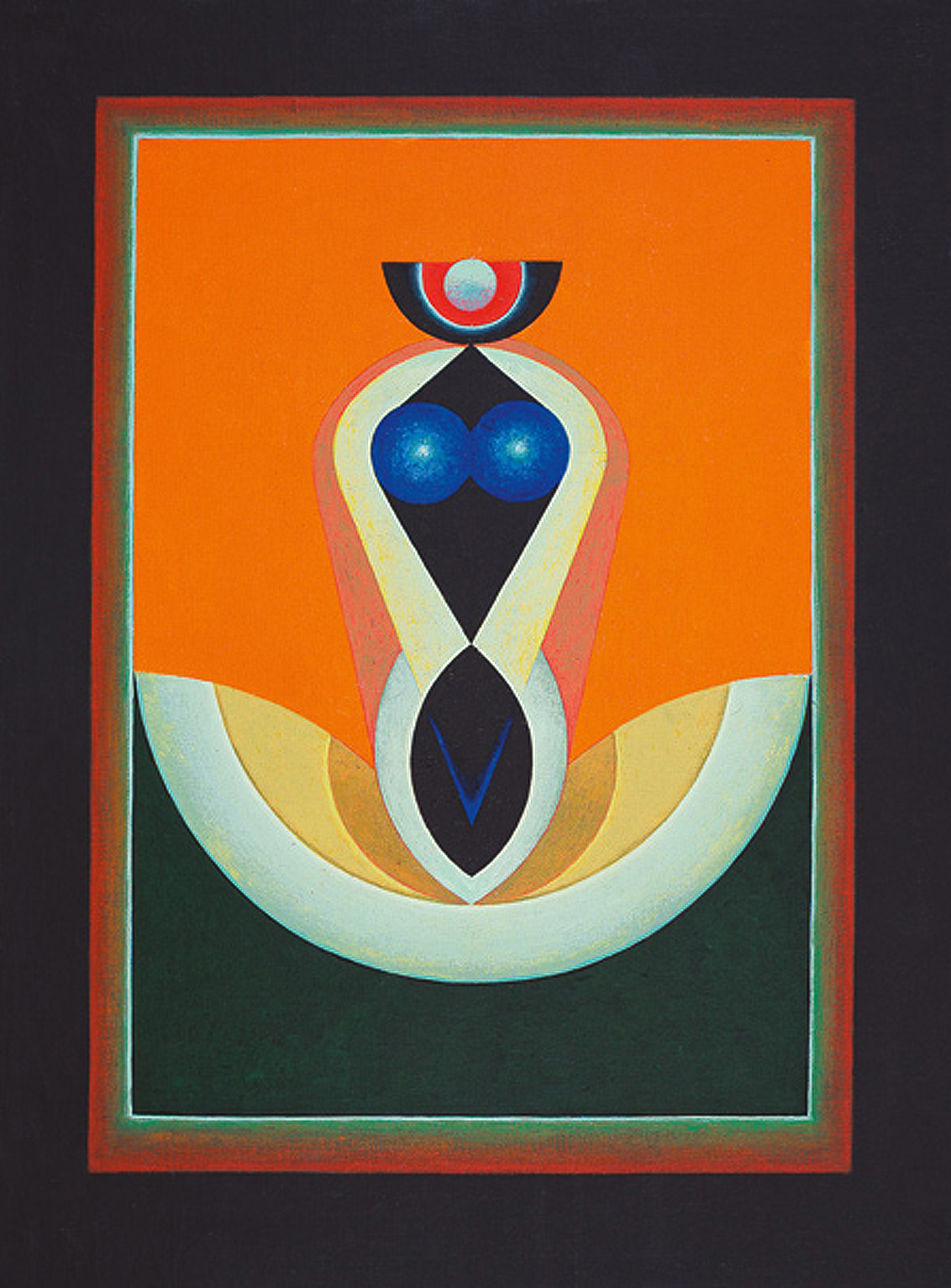


The practice of Tantra (from where the term Neo-Tantra originates) constitutes Mantra (utterance), Yantra (aid), and Mandala (circle) construction. Tantra, as a philosophical method and cosmological model can be described as the apprehension of the dual energetic principles embodied in the physical manifestation of reality. A union of Goddess Kali and her consort Shiva in later Hindu traditions (or in Western alchemical traditions as the Hieros Gamos).
The inherent dualistic nature of Tantra can be traced to one of the earliest ontological models of the universe contained within the Samkhya tradition of the ancient Indus Valley civilisations, in what is now modern day Pakistan.
Harappa and Mohenjo-daro mark two of the earliest known civilisations of the Indus Valley region (flourishing by 2500BC), whilst Goddess figurines and geometric forms such as the downward facing triangle have been found carved into stone goddess figurines from much earlier dates (25,000BC) and are considered to be yantra prototypes, of which the Sri Yantra is most well known.
Often these geometric forms are used in yogic and meditational practices, associated with naturalistic magic and aspirational goddess worship.
The Yantra (meaning tool or aid) is a composition made by means of arranging the primal abstract shapes of sacred geometry (such as the point, line, circle, triangle and square) around a central focal point, in order to represent equally, the stasis (Prakriti) and dynamism (Purusha) of the two opposing, primeval forces, prior to their anthropomorphism.
The human tantric practitioner strives for the unification of these two forces through an array of practices ranging from sexual rituals to abstinence from earthly pleasures, in an attempt to reconcile the infinity of consciousness with the limits of the material world. This can involve the contemplation of religious imagery or objects such as the lingam or yoni, as well as sacred geometricised diagrams (yantras) that become relevant at various transcendental stages of psychic and philosophical development.
These outcomes became one of the major philosophical differences between Tantra and Samkhya, the latter seeking to untangle the strands of consciousness from the material world as they accumulate over several lifetimes, as opposed to the ultimate unification of self with consciouness that was saught by the tantric practitioners.
The inherent dualistic nature of Tantra can be traced to one of the earliest ontological models of the universe contained within the Samkhya tradition of the ancient Indus Valley civilisations, in what is now modern day Pakistan.
Harappa and Mohenjo-daro mark two of the earliest known civilisations of the Indus Valley region (flourishing by 2500BC), whilst Goddess figurines and geometric forms such as the downward facing triangle have been found carved into stone goddess figurines from much earlier dates (25,000BC) and are considered to be yantra prototypes, of which the Sri Yantra is most well known.
Often these geometric forms are used in yogic and meditational practices, associated with naturalistic magic and aspirational goddess worship.
The Yantra (meaning tool or aid) is a composition made by means of arranging the primal abstract shapes of sacred geometry (such as the point, line, circle, triangle and square) around a central focal point, in order to represent equally, the stasis (Prakriti) and dynamism (Purusha) of the two opposing, primeval forces, prior to their anthropomorphism.
The human tantric practitioner strives for the unification of these two forces through an array of practices ranging from sexual rituals to abstinence from earthly pleasures, in an attempt to reconcile the infinity of consciousness with the limits of the material world. This can involve the contemplation of religious imagery or objects such as the lingam or yoni, as well as sacred geometricised diagrams (yantras) that become relevant at various transcendental stages of psychic and philosophical development.
These outcomes became one of the major philosophical differences between Tantra and Samkhya, the latter seeking to untangle the strands of consciousness from the material world as they accumulate over several lifetimes, as opposed to the ultimate unification of self with consciouness that was saught by the tantric practitioners.
"The colourless through colour, the formless through form." - G.R Santosh.

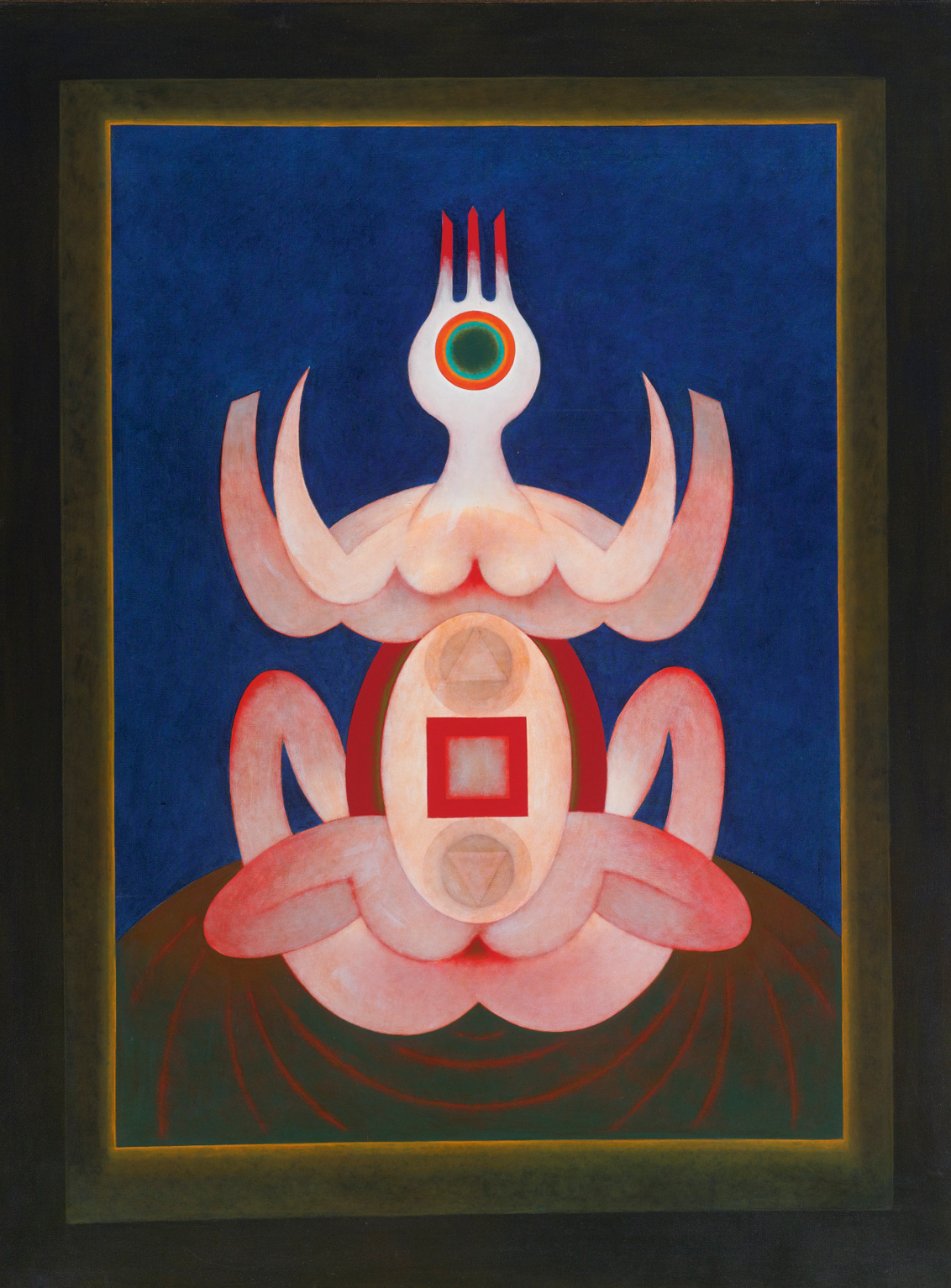
Nevertheless, the dualistic cosmological model at the centre of Samkhya, where two spheres of influence acting through each other to generate the phenomenal world of appearances, became crucial to the Yoga Sutras of Patanjali and remained interchangeable with Tantra, Vedanta and Yogic sadhanas in general.
This dualism, rather than being a moralistic dogma as used in religious state orthodoxy, was thought by many Hindu and Western scholars to emphasise the scientific and psychological values of Tantra’s dualistic practice via a dialogue with magic, which was, according to John Woodroffe (who translated the first Tantric text from Sanskrit into English in the early 1900’s) “common to all early religions”.
“Woodroffe and his Indian collaborators extensively referred to the fields of occultism, psychical research, psychology, physiology, Idealism, Monism, Vitalism, and other Western currents to argue for the scientific value of Tantra. They explicitly regarded Tantra as the essence of “Indian occultism” and the popularity of Western occultism as an expression of the tendency to rediscover an ancient orthodoxy. In this light, fascinating parallels between Indian reformers and Western esotericists become tangible: their exchange was largely based on a shared language of esotericism and comparisons between Western esoteric concepts and Indian teachings. In both cases, the rejection of modern materialism, scepticism, and atheism were a key component in the defence of orthodoxy or ‘tradition.’” (Strube)
This dualism, rather than being a moralistic dogma as used in religious state orthodoxy, was thought by many Hindu and Western scholars to emphasise the scientific and psychological values of Tantra’s dualistic practice via a dialogue with magic, which was, according to John Woodroffe (who translated the first Tantric text from Sanskrit into English in the early 1900’s) “common to all early religions”.
“Woodroffe and his Indian collaborators extensively referred to the fields of occultism, psychical research, psychology, physiology, Idealism, Monism, Vitalism, and other Western currents to argue for the scientific value of Tantra. They explicitly regarded Tantra as the essence of “Indian occultism” and the popularity of Western occultism as an expression of the tendency to rediscover an ancient orthodoxy. In this light, fascinating parallels between Indian reformers and Western esotericists become tangible: their exchange was largely based on a shared language of esotericism and comparisons between Western esoteric concepts and Indian teachings. In both cases, the rejection of modern materialism, scepticism, and atheism were a key component in the defence of orthodoxy or ‘tradition.’” (Strube)

“The fully Real has two aspects: one called Shiva, the static aspect of Consciousness, and the other called Shakti, the kinetic aspect of the same. For this reason Kali Shakti, dark as a thundercloud, is represented standing and moving on the white inert body of Shiva. He is white as Illumination (Prakasha). He is inert, for Pure Consciousness is without action and at rest. It is She, His Power, who moves." - Arthur Avalon.
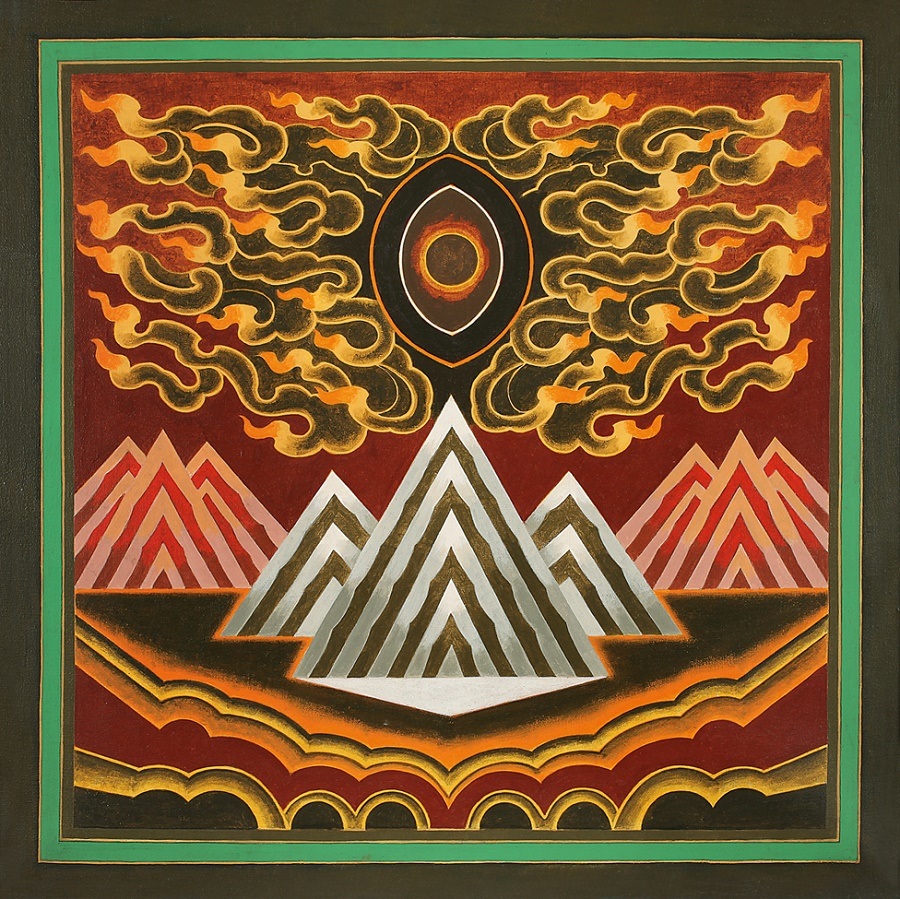


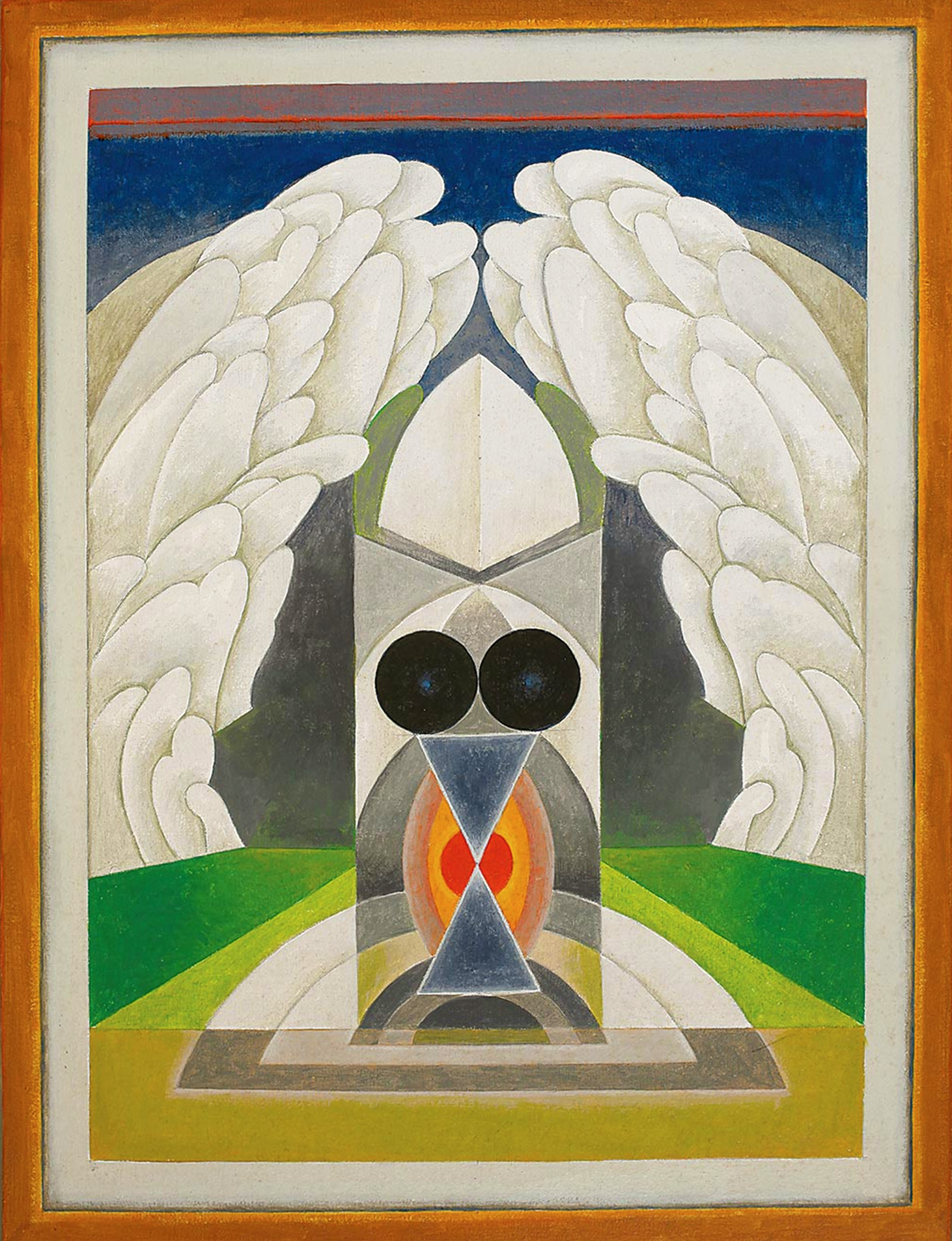

Woodroffe, who often wrote under the nom de plume of Arthur Avalon, was rarely a singular creative project but instead an intellectual collaboration between British and Hindu scholars who were united under a name relating to the myth of King Arthur, that bore a common, cosmological cultural origin with the forest-dwellers of India, the Druids, the Rosicrucians and the Freemasons, in an effort to preserve an unbroken esoteric tradition that seeded Hindu philosophy and was but a fragment of a complex folkloric tradition that spanned India, Egypt and the British Isles during the prehistoric era.
Although Neo-tantrism emerged in the 1960’s, helped in part by the Tibetan uprising against Chinese communist authorities which drove the Dalai Lama and other religious leaders into exile in India and the West, it’s complex visual lexicon of symbolic language grew directly out of the long lost traditions of experimental science that crystallised within ancient Tamil script and Sanskrit as the language of metaphysics. A subsequent cross-cultural critique from scholars, poets, musicians and visual artists embedded on either side of their respective cultural boundaries, served as agents of harmony, in much the same way as the dualistic (creative and destructive) philosophy of Samkhya suggests.
This rich tapestry of visual exchange between cultures tends to focus the folklore in such a way as to centralise mythology and preserve commonalities in relation to an ecology of the spirit in times of political, climactic and technological change. Such exchanges, via painters like Santosh, writers like Woodroffe and organisations like the Theosophical Society, have historically provided new dimensions of thought by reconnecting with ancient principles of natural science and cosmology, via the acknowledgment of the sacred geometric forms that remain concealed in time and latent in space.
Although Neo-tantrism emerged in the 1960’s, helped in part by the Tibetan uprising against Chinese communist authorities which drove the Dalai Lama and other religious leaders into exile in India and the West, it’s complex visual lexicon of symbolic language grew directly out of the long lost traditions of experimental science that crystallised within ancient Tamil script and Sanskrit as the language of metaphysics. A subsequent cross-cultural critique from scholars, poets, musicians and visual artists embedded on either side of their respective cultural boundaries, served as agents of harmony, in much the same way as the dualistic (creative and destructive) philosophy of Samkhya suggests.
This rich tapestry of visual exchange between cultures tends to focus the folklore in such a way as to centralise mythology and preserve commonalities in relation to an ecology of the spirit in times of political, climactic and technological change. Such exchanges, via painters like Santosh, writers like Woodroffe and organisations like the Theosophical Society, have historically provided new dimensions of thought by reconnecting with ancient principles of natural science and cosmology, via the acknowledgment of the sacred geometric forms that remain concealed in time and latent in space.
“Having been in constant contact with the living growth of nature, his mind was free from the desire to extend his dominion by erecting boundary walls around his acquisitions. His aim was not to acquire but to realise, to enlarge his consciousness by growing with and growing into his surroundings.”
- Rabindranath Tagore.
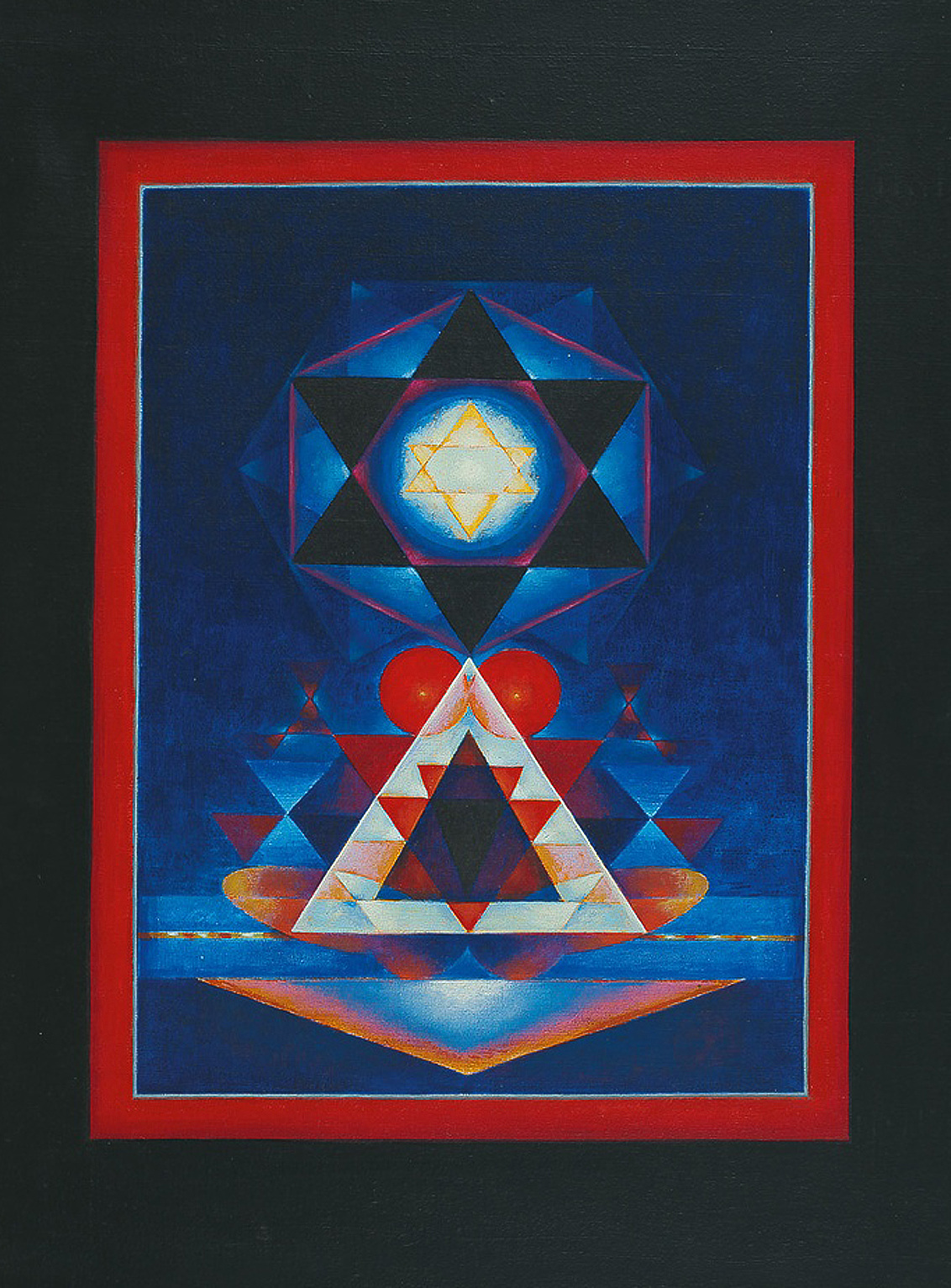


Further Reading ︎
‘Awakening’, Retrospective Publication
A View Of India's Modern Tantric Art, Jane Greenstein
Articulating the Modern, article, Rebecca M. Brown
Sādhanā - The Realisation of Life (1916), Rabindranath Tagore
Tantra as Experimental Science in the works of John Woodroffe, Julian Strube
Shakti and Shakta, Arthur Avalon